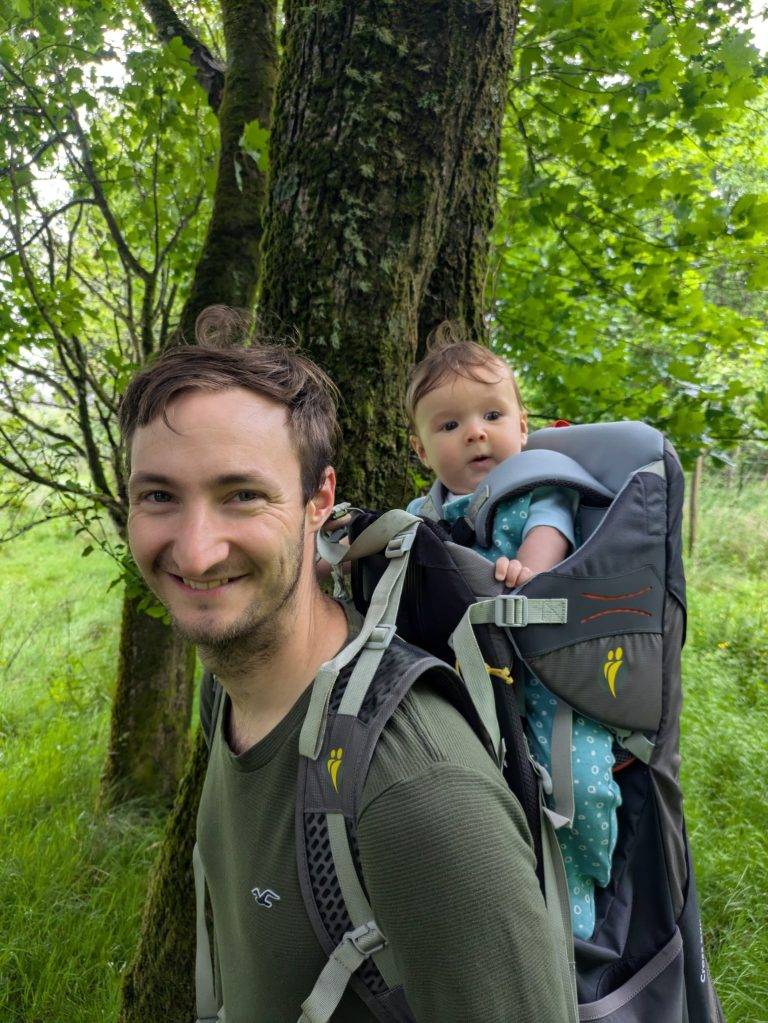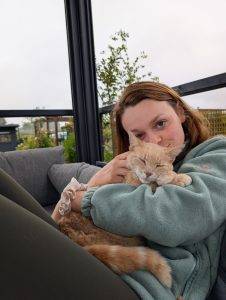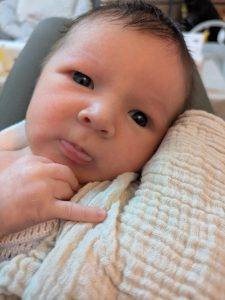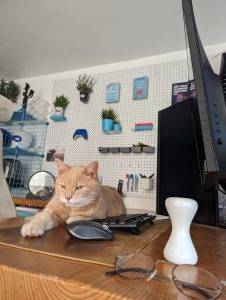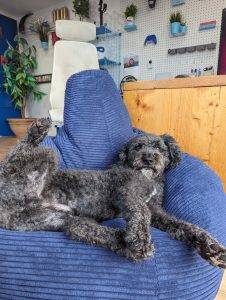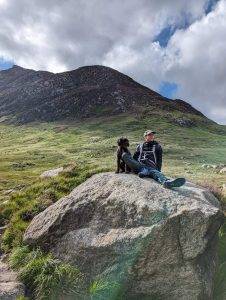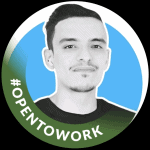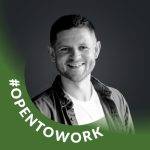Hi, I’m Nicholas Robb, the world’s worst employee.
Over the last 10 years I’ve grown my design sidehustle into a profitable design business, created a new plan for my lifestyle, cut my workweek in half, and now work remotely on passion projects from a small office surrounded by nature, where I split my time…
- Running my design agency “Design Hero”.
- Creating Life By Design, my education business
- Writing a book, “how to train your clients“
- Building an ambitious japanese garden
- Raising a son
- Hiking, walking and wandering
- Building things.
But for more than 10 years my passion was just a sidehustle and made no money.
Long before I ran my own business I was an employee.
I felt trapped, underpaid and undervalued in 9-5 jobs, unable to action my ideas, I had no control over my own time.
Been there, done that, had the heart-attack.
I took a very roundabout route into my current life:
For years I worked like an dog trying to get ahead in a 9-5,
I originally studied product design, I walked away from a promising career in architecture to pursue web design, because “design is my passion” 😅
But I read that an estimated 60% of people work in jobs they are unsuited to or unhappy in; They just take the trajectory that life throws at them.
We only have 1 life, and it’s pretty short, we are going to spend a lot of it working, so it’s better to pursue your passions.
I don’t claim to have all the answers, like everyone I’m still working things out as I go.
We’re all at different points in our journey and can learn from each other.
But I see a lot of freelancers work crazy hours and are still stuck earning less than they would in a low-stress 9-5 job.
Most people start a business or a sidehustle for freedom, get overwhelmed & fit life around whatever time remains.
I want to help solopreneurs to design ther ideal lifestyle first, then build a one person business that supports it.
Of course, different people will have different views on what “ideal lifestyle” means.
That’s up to you to figure out for yourself,
But hopefully the strategies, systems and frameworks that I share here will help you figure it out.
But For me, success is a highly systemized lifestyle business that brings in minimum £10k/m on a 3-day workweek, leaving me time to work on my other non-profit interests.
This is what worked for me to grow a solo business with profit, freedom, and stability.
This is my story:
Beginnings
I have always enjoyed design as long as I can remember, first as a hobby then as a side-hustle.
At school I was bullied hard because I was an introvert, I was a short-arse, and I liked all the geeky stuff that hadn’t become fashionable yet.
It’s funny how conformity is an asset in an instiutional or corporate setting, and a crutch in the real world.
Later those same skills and traits that make school miserable would help me a great deal.
I always wanted to do design work:
Since I was young, I have always created and designed things as a hobby.
I enjoyed drawing superhero characters, first in pencil then later on Photoshop (I’m still using CS5 btw 😅).
What started as band posters for pals turned into logos for family friends,
and so the “Design Hero” sidehustle was born.
So I’ve always been a freelancer, I guess.
It earned me some extra pennies while I was studying at university,
where I picked up a continuous new stream of skills such as 3d Modelling, rendering, animating, presenting in front of a crowd, plus valuable soft skills like sleeping upright with your eyes open in class.
It’s amazing how your hobbies and skills can be turned into leverage.
Later as I went into the world of work I kept sidehustling as a way to boost my income.
It never made much money, as little as £200-500 a year.
This is something most gurus online don’t talk about. People aren’t honest about it on social media:
Every time I see an overnight success story:
“BOLLOCKS!”
It’s a harmful myth that makes people feel crap about where they are.
We all have different starting points, different responsibilities and advantages/disadvantages.
But the truth is if you want you grow your own business, if you want true freedom, if you want to escape the ratrace…then it takes many years of working hard for little reward.
Most “overnight” success stories actually started decades ago, picking up all the skills you need to run a business.
And every overnight success you see is just action + consistency + time.
Most people aren’t willing to work hard for no return for a few months, never mind a few years.
I think most people are not willing to put in the work for that long for the payoff.
Everyone wants the hack, the quick win, the shortcut to success.
I kept my sidehustle going through university, and along side full time jobs.
Every year, my clients, and my earnings, grew tiny bit by bit. Eventually, it would reach a point where I started to glimpse it as a full-time income, and it woudl fund the lifestyle I wanted.
But first, I had to experience all the shitty jobs there were, to know what I didn’t want.
My first jobs
My first job was that humble Millenial right of passage, a paper round, where I learned valuable life lessons about capitalism, free markets, and the nature of work.
I also worked at an engineering firm turning paper drawings into CAD drawings, before studying product design originally.
By “product design” I mean actual physical products, not UX design as it’s commonly known as now.
But Iin terms of work I pivoted into architecture, working in the family business, and also as an architect in Glasgow.
My passion for web design wouldn’t go away though and eventually I made a difficult decision to leave the family business to do web design full-time, which was the hardest conversatin I’ve ever had.
I then proceeded to apply for, get and walk out of a string of underpaid jobs in web design.
I learned a lot about what I didn’t want my life to look like.
Like most people, my pay lagged behind my worth.
My first job I loved the work & team, I learned a lot very quickly, but I simply wasn’t being paid enough.
My next job was a shitshow in the culture department, there were daily dramas, and bosses screaming at staff members like Wolf of Wall Street, except with Scottish accents.
The last job I ever had was better, but I had grown the business considerable, there were promises of compensation that never materialized.
So much for “work hard and it’ll pay off”.
This whole time, I had still been working on Design Hero. No marketing, just referrals.
“If I can make just £2.5k/m then I can quit my job”.
I was desperate to find enough work to sustain me, but I just couldn’t find enough leads.
If I could go back in time, and give myself this automated referral system, I would have hit 6 figures years earlier.
I reached a point where I just got fed up of working for other people.
I wanted to avoid the boss’s silly ideas, work in my pants, and be able to go outside when it’s sunny. 🤣 🩲
Everyday, I talk to freelancers who are in this stage:
Talented as hell,
stuck in a rut,
working harder than any employee,
but have less time and STILL earn less than than many in steady 9-5s.
I was in this trap too, because I kept following all the common advice online…
I’d spent years by now reading about how the most successful entrepreneurs designed lifestyle businesses, experimenting and optimizing my business, and putting everything I’d learned into practice.
I started spending money on courses to get help.
A few of these were great. But most were crap:
They all told me how to do MORE.
- 🔵 more leads
- 🔵 more ads
- 🔵 more engagement
- 🔵 more AI
- 🔵 more posting
- 🔵 more shiny objects
- 🔵 more training
I spent over £10k on courses and coaching.
And it worked. Sort of…
My sidehustle overtook my wage
I signed up for an expensive coaching package, which overpromised and underdelivered.
But it did give me a high leverage skill, by teaching me about building offers,
plus years of honing my sales skills on calls,
learning how to manage clients,
honing and refining my process,
and finally Design Hero was looking a bit more promising as a full time thing.
But for some reason I still didn’t quit the 9-5…
I had moved jobs by now and was quite happy there.
Too happy in fact…
I was too comfortable. The boss was a nice guy and a hard worker. I was being paid a little more:
(Though in hindsight it’s wild how underpaid I still was.)
I was helping scale a business to 7 figures, my job title said “web designer” but my roles included….
- Designing brands,
- Management a web developer
- Web design,
- SEO,
- Content generation
- Managing a social media team member
- I was also involved in business strategy
- and whatever else I could turn my hand to.
By this time my sidehustle had led to an expansive generalist skillset.
I didn’t know it, but I already had all the skills I needed to go out by myself and start a one person business.
A wakeup call
I remember during lockdown I was officially furloughed, but unofficially I was expected to work on the sly.
Around this time I think everyone had their “great awakening” and we all had a glimpse of what life could be, outside the status quo of the commute, the 9-5 etc.
Personally, looking back I’m glad I had to work.
I’m not made to be idle. I don’t think anyone is.
I watched people go nuts, drinking, bored out their minds, addicted to Netflix.
But they also had time with family. Time to get outside during the day and walk in nature.
Amazing how quickly we all stopped valueing that, the moment the restrictions were lifted.
At this time I started reading prodigiously.
I read books by the masters of
I read books about lifestyle design every day, I read like a mofo, and then I read some more.
This opened my eyes to what is possible…
Most people aren’t even aware of what is possible with the right knowledge.
Read every day for 6 months and you won’t even recognise yourself.
Reading opened my eyes:
I became dissatisfied with the idea of working a 9-5 the rest of my life, of being underpaid, undervalued, constrained in my hours and actions.
It was no longer tolerable.
At that point I thought; “if I can just get x2 clients a month at 1k each I could quit”.
It lit a new fire in me, and I remember calling up enquiries on the way to and home from work, and designing logos for £120 on my laptop or in the back of my car or on park benches during lunch breaks.
During this time Design Hero was catching up on my full time wage and I started thinking, “yeah I’m going to have to leave soon”.
But still something held me back… I kept setting these targets and saying WHEN…
“When this happens, or that happens then I’ll quit”
Luckily, fate came along and decided for me.
From Fired to Freelancing
We were about to move house. I had applied for a mortgage.
Then I got fired the day I was going to ask for a raise…
I don’t believe in fate, but it sure was quite a coincidence.
I’m not proud of how it came about.
I’d never lied about working on Design Hero, I just didn’t talk about it much.
At the time I was working remote from home, and I made the fatal mistake of calling an enquiry for Design Hero during work time.
It was my failure and I shouldn’t have done it.
But I’m really not proud of it, it makes my cheeks burn even thinking about it now.
I failed to maintain a proper separation between work and my sidehustle;
Something I was normally strict about but I self-justified it because I often worked late and overtime for my 9-5.
I never asked or expected to be paid overtime for this, working hard is just part of who I am. So I didn’t see any harm in swapping the time and making it up later.
But it was a conflict of interest, he found out and fired me on the spot.
I don’t blame him, he was a nice boss.
I think he was hurt as he felt understandably betrayed and that I was living a double-life.
My boss had been pretty happy my work, but when he found out about Design Hero he said he felt I was living 2 lives…. he wasn’t wrong.
During the day I was helping him build his business whilst my heart was in building my own thing.
Most of the skills his business benefited from during the day was stuff I’d been learning in my own time for decades.
So I justified it as was making up time later so I felt it was ok.
Important lesson for me when I became a leader:
your team will have sidehustles, it’s the new normal.
If you want them to stick around, bring them into the open, support their sidehustles and coach the gap to help them grow.
He was really great about it in the end, and actually asked if I could come back.
If you’re listening now, overall you were a nice guy and I’m very sorry.
Looking back now, as a boss myself,
I do think it’s naive to think that people who work for you won’t also work for themselves.
This is even more true now as living costs outpace the rate of pay.
There’s a certain type of person who is always learning.
Who picks up multiple valuable skillsets. Who takes initiative without instruction.
Who questions “Why”? Who stays curious, works hard and outgrows their job title again and again.
If you are someone like this, then most bosses at small businesses can’t afford to pay you what you are due and you’re probably destined for freelancing or solopreneurship.
I try to keep this in mind. If my team have aspirations, instead of trying to stop them, or making them think they have to hide it, I teach them, help them, and advise them.
Flying solo as a freelancer
I see being fired as a turning point:
I had this massive shift in mindset and saw a quantum leap in progress,
and my revenue from Design Hero followed suit, doubling every year for the next 3 years in a row.
I thought now that Design Hero was my only job I’d have loads of free time.
But it turns out your work expands to fill the time you have.
I basically just stopped working 9-5 and replaced my day job with working on Design Hero 24/7
Like many freelancers, clients ruled my life.
I burned my evenings and weekends to get ahead.
And I always wanted to be better. There was always one more milestone just out of reach.
The difference was mindset:
The work was hard & stressful. I was having a “midlife crisis” every midweek 😅
But I was building my own thing.
What I’ve learned about myself is that for a certain kind of person, coasting is another form of death and you’ll feel bored and unfulfilled.
Too much Work-life balance isn’t good for me.
I need the challenge to occupy my mind, and grow as a person.
When things go smoothly I get bored & starting doubting my whole life.
When I’m growing and pushing myself, I moan a lot and feel stressed, but I’m driven & have purpose.
But you also can’t grow and have record months forever. It’s too stressful, you’ll have a meltdown.
So you have to adjust in between profit vs purpose vs freedom continuously.
For this phase of my life I was focussed on one thing:
Profit.
I had become obsessed by the idea of hitting £10k/m; a goal which had been implanted in my brain by some social media guru or other,
And I was working pretty hard to make it happen.
You can’t skip the hustle phase when starting a freelance career. But it’s not sustainable.
Eventually caught up with me in a big way…
The burnout
For years I worked like a dog trying to grow the business.
I had no idea what I’d do when I got there.
Turns out I would just set a higher income target and keep chasing.
Over the next 2 years I grew my design sidehustle into a solo business.
After a year there were some months earned more than my whole annual salary from my last job.
It rewrote what I thought was possible as a freelancer.
I soon smashed the arbitrary monetary target.
But of course, as soon as I reached it, I had to set a higher goal.
But the truth most gurus won’t tell you….
Despite those highly curated rags to riches stories you see on social, the truth is that there is no such thing as overnight success. And even when you achieve it, success doesn’t = happiness:
Everyone online has advice about how to grow a 6 figure business. But no-one wants to tell you what happens AFTER…
When I hit my first £10k month I was miserable.
I had reached 6 figures, I had more prestigious clients, I had authority in my niche; The BBC even asked me to speak at schools about careers in design.
I looked like success.
But I didn’t feel like a success.
At this early stage of my freelance career I was already totally burned out.
I had everything I’d worked so hard to achieve.
So why was I so miserable?
Because I fell for the same trap that most freelancers do:
I was trying to measure my success by my revenue.
You see, everyone promotes the startup model. Huge growth, big risk, large teams.
But life is short, and then you die.
If you want to start putting life first,
If you started this business for freedom,
If you want time to enjoy your life….
Then what you actually want is a lifestyle business.
A “lifestyle business” generates enough money to live comfortably, but with more personal freedom baked into the business.
Now, “Enough” is different for everyone.
We are all in different situations with different responsibilities and preferences.
But I realised after you have “enough” then free time is far more valuable. I realised if you want to grow a 6 figure business without the burnout, then you have to think differently.
In a lifestyle business, your revenue means nothing!
Tell me about your profit…
That also means nothing.
Tell me about your profit ÷ time
Now we’re getting somewhere…
Now tell me what you do with your spare time.
Now you have a more accurate picture of your success.
Don’t use the wrong measuring stick for success.
This is the point of my story that I realised this common truth:
After you have enough, more money won’t make you happy.
This cliche is so commonplace it’s practically gospel.
But it’s something you have to experience first-hand to understand.
Information is hearing it, wisdom is living it.
I feel fortunate. It’s a good problem to have.
Certainly better than not having enough.
‘Enough’ is different for everyone. But it’s probably less than you think:
I have a theory most folk would be much happier earning £50k/yr on a 3day workweek than £120k+ working 5 days.
After you define, and reach “enough”, time quickly becomes far more valuable.
Where some spend obscene amounts of money on status symbols like watches, cars, and clothes, I would spend what some would call obscene amounts of money, just to buy back my free time.
Every I know making 5 figures wants to make 6 figures. But everyone I know making 6 figures is trying to figure out how to get back time.
This is the mindset that led to me growing from a freelancer, into a solopreneur, and then with my first hires as an agency owner.
From Freelance to agency owner
Looking back, building a sidehustle whilst working full-time was hard work, but it gave me a huge advantage over other designers:
I knew how to horde and manage my time like a precious resource.
Because my time was so limited I was forced to work differently:
I had to work smart not hard.
I had hours to do work that would normally take days.
I couldn’t visit their offices to pitch, or do networking, or answer the phone during working hours.
So I built systems, automations, scheduling, templates etc. to 10x what limited time I have.
This was the foundation that allowed me to scale a solo business without just working longer hours.
Systemizing my solo business was the foundation that allowed my business to scale without me putting in more time.
Nevertheless, there’s a limit to how much you can grow by yourself…
By that point, I’d spent ten years building websites, and I had to continue to support existing clients, whilst finding new ones to grow my income.
My first hire was someone to help me with small support tasks for WordPress sites.
Moving from doing everything yourself to having help with fulfilment, freed me up to work on big picture tasks, growth, sales, systemizing your business etc.
By the next year I’d managed to optimize my business down to a 3 day workweek.
I still think of it as a solo business, but in truth, Design Hero is now a micro marketing agency for startups.
I spend more time running the business, training, building systems and on strategy etc than doing design and fulfilment these days.
It’s a new set of skills to learn, new challenges, new problems.
But life is always learning.
In a solo business, you ARE the business.
So personal growth = business growth.
They say being a manager is watching someone take x10 longer to do the job half as well as you would lol.
But as always you have to think super long-term.
I teach every team member, freelancer or VA as if they were a student, and were paying for my time.
I take the time to review, critique and explain everything I do for them.
I record my work, explain my thinking, outline the strategy, the Why, and the Why nots.
I teach the soft skills like client management, policy settings, boundaries etc, all the difficult stuff that they can’t teach you in design tutorials on Youtube.
But if you take the time to train, and to teach, with patience, it pays off in the form of more freedom.
From Agency Owner to Mentor
At this point I had enough money to live comfortably.
I also had free time.
At first I used this time for leisure.
I hiked,
I played video games,
I worked in the garden,
I took bike trips,
I got into motorsport.
It was a great summer.
But I’m not made to sit still.
I started to feel a creeping anxiousness that I couldn’t explain….
I used the Five Whys, a framework I use to deal with burnout, to work through it basically found that when things get too easy, I get bored.
So I sought my next challenge and took time to think about my life and what I wanted to do.
I sought something which would give me a sense of purpose, of how I could do something with meaning, and started setting some new goals.
But as with most goal setting frameworks, goals and plans only get you so far.
Life is usually the average between your plans, your habits, and the pure chaos of life.

Just as I never set out to be an agency owner, I never set out to be a mentor either, it just happened as a result of the actions I was taking every day.
Teaching my team naturally led into teaching other freelancers.
I was already recording training, doing daily teaching and coaching to nurture my team’s skills,
and I was already open-sourcing most of it on the Life by Design blog.
My freelancers, unprompted, said instead of me paying them, they should really be paying me, for the stuff I was teaching and mentoring.
That was a signal from the universe I couldn’t ignore.
I found purpose in using my skills, my knowledge, plus my positioning, to help other freelancers navigate the problems I’d already had.
I was already getting questions on social from freelancers on how to solve some of them.
I repurposed my social accounts for my coaching platform, I write every day about running a multi-six-figure business on a 3 day workweek,
and I share the systems and strategies I use every day in Design Hero.
So here, I write about all the problems I’ve had, how I solved them, and how to do it while avoiding burnout.
(spoiler alert, I still get burned out sometimes!)
It doesn’t make much money.
But I treat it the same way as I did Design Hero when it was still a sidehustle:
Instead of focussing on profit, I treat it as getting paid to learn about coaching, and learn my audience’s problems.
I write for the sake of writing and nurture the habit,
and because it gives me purpose to help freelancers.
They bring me problems from running a solo business and I give solutions that have worked for me.
I also teach a 12 week programme with 3 modules that turns frustrated freelancers into systematic solopreneurs. You can see the results of that here.
- Design your ideal lifestyle and reverse engineer it into an actionable plan
- Optimize the offer, sales funnel and build a pipeline of leads for a safety net of profit
- Systemize the business to buy back your free time
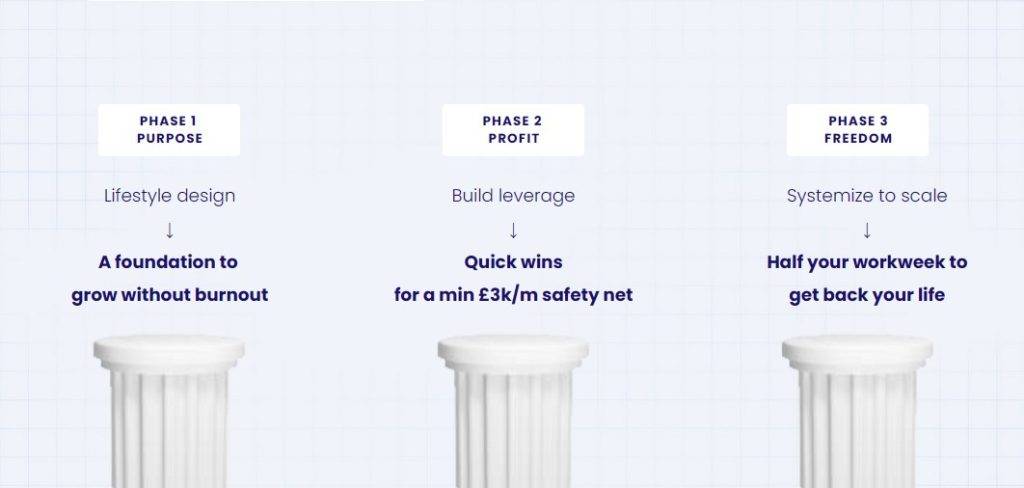
If you’d like to know more about it, just hit me up here
Where I am now
So now I’m 35, I’ve still got most of my hair, I’ve got a healthy son, there’s still plenty of challenges but life is good.
What’s next for me?
I’m not sure yet, I’m in a stage where I’m still figuring out what the next 5 years look like for me.
Things can and will change.
But for now my focus is on writing my book “how to train your clients” and on producing the best content I can for Life by Design.
Design Hero is systemized down to a 4 hour workday. There’s always room for growth.
But it earns me a living & leaves time for family & for passion projects like Life by Design,
where I can help solopreneurs to design their own ideal lifestyle & rebuild their business to support it, just like I did 5 years ago.
If you’d like to start exploring some exercises in lifestyle design…
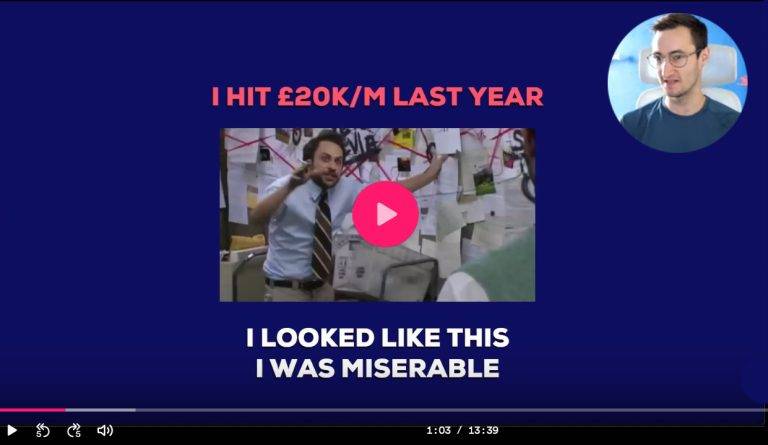
I'll walk you through 6 systems you can use to build a freelance business which puts life first
Subscribe for instant access to my guided lifestyle design workshop for freelancers.

